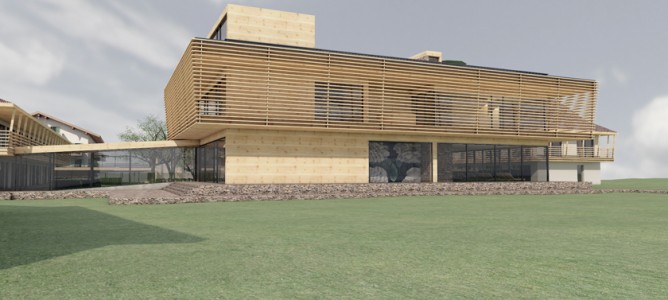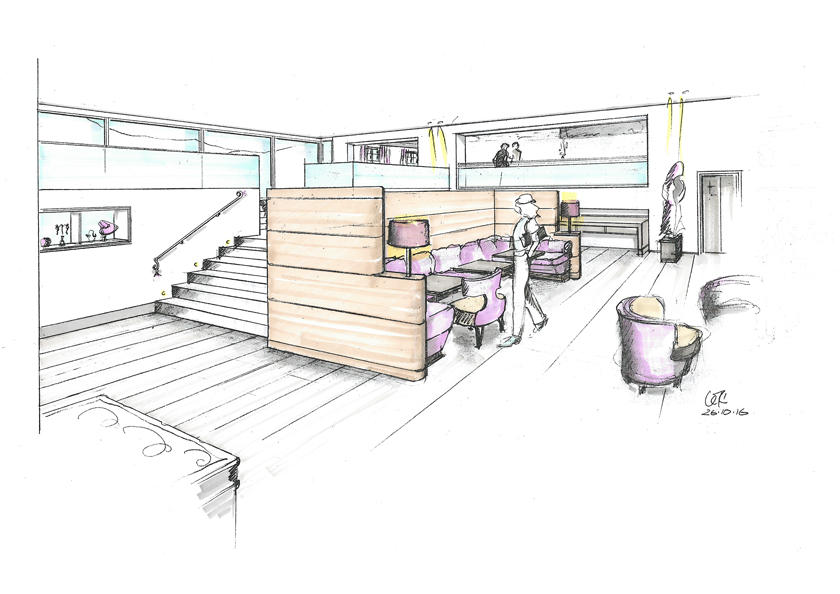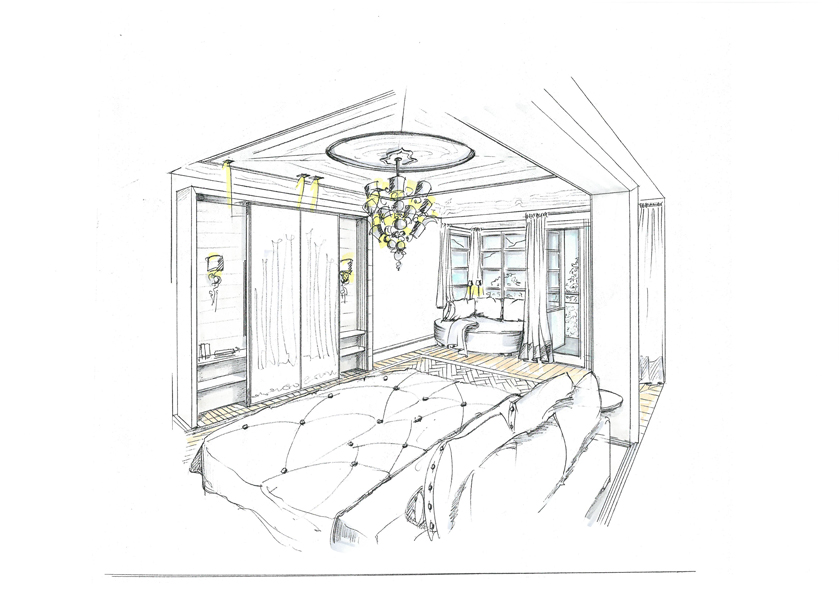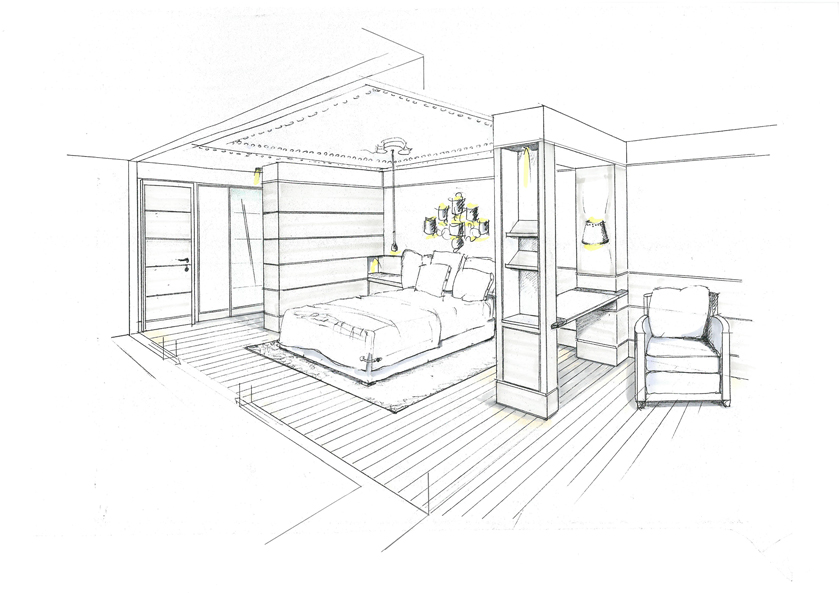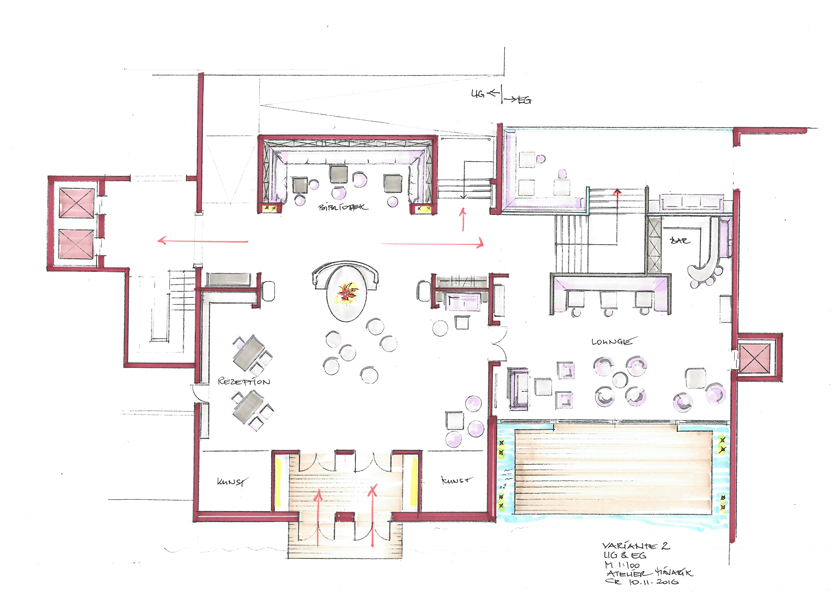Hand drawings and renderings: the start of every project
Hand-made drawings are an elemental component to my work as an interior designer. I use them to visualize and make designs tangible for my clients. In a second step, we at Atelier Minarik create computer-generated renderings. In the following, I’d like to explore both types of graphics in a bit more detail.
Hand-made drawings and colorings
Aren’t interior hand-drawn designs a bit old-fashioned in the age of CAD? That may be a legitimate question. My answer is: while they may be old-fashioned, they definitely are not past their time! And not just because they are captivating in their charm. Generally, my projects always start with pen and paper.
- Drawing by hand saves time and costs
Many clients find it easier to envision the final outcome via a sketch. Floor plans are usually too abstract to get a feeling for a space. A free-hand sketch can also be created swiftly during a site visit and provide a foundation for communication between clients and interior designers. In today’s world, free-hand sketches aren’t meaningless scribbles, but rather a great means to facilitate better communication and save time.
I use this opportunity on a regular basis, and would not trade the ability to draw for any mobile computer program, however good it may be.
The nice thing about free-hand drawings is that an interior designer can let creativity flow freely. It is in the second step that I usually implement a computer. And there, too, hand-made sketches are an ideal foundation for working digitally. Those who are skilled at using 3D visualization programs like AutoCad, 3D Studio MAX, or ArchiCad will be well-advised to master the fundamentals of drawing, too.
- Hand-made drawings as an expression of individuality
Manual drawings give a project the interior designer’s personal signature. Personal preferences and skills find expression. To be sure, there are a great deal of interior design offices today now working exclusively with computers. Those who are familiar with my work know that I appreciate deep-rooted values and traditions, and therefore enjoy combining traditional aspects with modern ones. Hand-drawn sketches are simply a part of my profession and my style. In my many years of professional practice, they have always proved their worth to me.
Today’s study programs often no longer place much value on drawing by hand. Many young graduates have difficulty when it comes to creating hand-drawn sketches. A small tip from me: there are still excellent drawing courses out there today for architects where you can learn from scratch the “ancient art” of drawing by hand. Drawing is always related to imagination. And, at the end of the day, that is something we interior designers need a great deal of.
The most important drawings in interior design
Drawings give structure to spaces on paper. The initial sketches commit ideas to paper. Technical drawings, on the other hand, are significantly more sophisticated and accurate.
The floor plan provides a horizontal cross-section of a home to scale. It looks as if you were viewing the floor of the apartment or the house from above. Floor plans provide an overview of the proportions in the rooms and the distribution of the walls, doors, and windows.
A cross-section shows the vertical segmentation of a building from a certain line on the floor plan over to the next wall.
An axonometric projection is similar to a floor plan with a three-dimensional effect.
A perspective contains textures and light sources, generating a sense for spatial depth. It shows the room from a certain perspective in application of vanishing points.
Computer-supported renderings
Generating drawings on a computer with the aid of CAD programs enables the creation photo-realistic images of interior spaces or entire buildings. You don’t need to have the same level of dexterity that manual drawings require, but you do need to have technical savvy and know-how to use various programs. CAD, by the way, stands for computer-aided design.
When it comes to 3D visualizations for my clients, I enjoy collaborating with my colleague Andreas Möller. In my blog article, “Interior Design Meets Industrial Design,” you’ll find further information about him and our 3D visualizations.
With the aid of photo-realistic renderings, I can present the effect the new room design will have to my customers in advance. Or, as seen in the images here, I can make the modernization measures planned tangible. This provides my customers with a sense of certainty since they obtain an accurate picture of what the final result will look like. This is very helpful in all aspects of my work, be it interior design, furnishings, or interior decoration.
We usually create various versions, which I then use to produce the final room concept, working closely with my clients. Thanks to these photo-realistic images, it becomes significantly easier for clients to decide on a certain lamp, flooring, or a new color palette when they get a solid impression of how the space will feel.
Curious to see how your apartment, home, or office could feel after modernization? Feel free to contact me and I’ll show you what kind of potential can be found among your own four walls!

